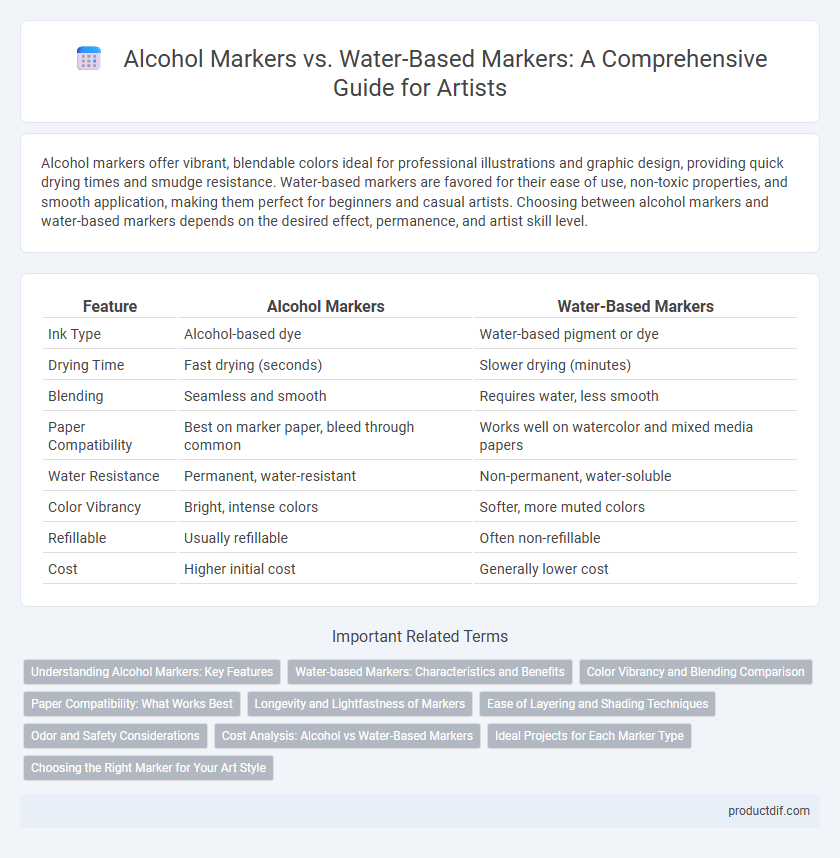Alcohol markers offer vibrant, blendable colors ideal for professional illustrations and graphic design, providing quick drying times and smudge resistance. Water-based markers are favored for their ease of use, non-toxic properties, and smooth application, making them perfect for beginners and casual artists. Choosing between alcohol markers and water-based markers depends on the desired effect, permanence, and artist skill level.
Table of Comparison
| Feature | Alcohol Markers | Water-Based Markers |
|---|---|---|
| Ink Type | Alcohol-based dye | Water-based pigment or dye |
| Drying Time | Fast drying (seconds) | Slower drying (minutes) |
| Blending | Seamless and smooth | Requires water, less smooth |
| Paper Compatibility | Best on marker paper, bleed through common | Works well on watercolor and mixed media papers |
| Water Resistance | Permanent, water-resistant | Non-permanent, water-soluble |
| Color Vibrancy | Bright, intense colors | Softer, more muted colors |
| Refillable | Usually refillable | Often non-refillable |
| Cost | Higher initial cost | Generally lower cost |
Understanding Alcohol Markers: Key Features
Alcohol markers feature fast-drying, non-water-soluble ink that allows for smooth blending and vibrant, long-lasting colors ideal for professional artwork. These markers typically have dual tips, including fine and broad nibs, providing versatility in detailed line work and broader shading. Their pigment-based formulation resists fading and smudging, making them popular for illustration, design, and mixed-media projects.
Water-based Markers: Characteristics and Benefits
Water-based markers provide vibrant, blendable colors with minimal odor, making them ideal for artists seeking non-toxic materials. Their quick drying properties prevent smudging while allowing smooth layering and shading techniques. These markers are versatile on various paper types and easy to clean, appealing to both beginners and professionals focused on precision and detail in art projects.
Color Vibrancy and Blending Comparison
Alcohol markers deliver intense, vibrant colors with smooth blending capabilities that allow seamless gradients and rich saturation, making them ideal for professional art projects. Water-based markers offer a softer color appearance and are easier to blend with water for subtle transitions, but their vibrancy typically remains less bold compared to alcohol-based alternatives. Artists often prefer alcohol markers for striking color intensity and durable finishes, while water-based markers suit techniques requiring gentle blending and layering effects.
Paper Compatibility: What Works Best
Alcohol markers perform best on smooth, non-porous papers like bleed-proof marker paper or specially coated cardstock to prevent ink from feathering and bleeding. Water-based markers are compatible with a wider range of papers, including watercolor paper and standard sketchbooks, as their water content allows for blending and less absorption issues. Choosing the right marker depends on the paper's texture and thickness to achieve optimal color vibrancy and blending effects.
Longevity and Lightfastness of Markers
Alcohol markers offer superior longevity and excellent lightfastness, making them ideal for artwork that requires durability and resistance to fading over time. Water-based markers tend to be less lightfast and can fade more quickly when exposed to sunlight or harsh lighting conditions. Artists prioritizing archival quality and long-lasting vibrancy often prefer alcohol-based markers for their consistent color retention and robustness.
Ease of Layering and Shading Techniques
Alcohol markers offer superior ease of layering and shading techniques due to their fast-drying, blendable ink that allows smooth color transitions without streaking. Water-based markers tend to re-activate with water, making layering more challenging but ideal for creating gradients and subtle shading effects through dilution. Artists often prefer alcohol markers for vibrant, seamless blending and water-based markers for delicate, painterly shading styles.
Odor and Safety Considerations
Alcohol markers emit a strong, distinct odor due to their solvent content, which can cause irritation or headaches in poorly ventilated areas, making them less suitable for sensitive users or enclosed spaces. Water-based markers have a mild, often negligible scent and are generally considered non-toxic, posing fewer health risks and making them a safer choice for children and artists with respiratory concerns. Safety considerations favor water-based markers for prolonged use, while alcohol markers require adequate ventilation and caution to minimize exposure to fumes.
Cost Analysis: Alcohol vs Water-Based Markers
Alcohol markers generally have a higher upfront cost, often ranging from $3 to $7 per marker, while water-based markers typically cost between $1 and $3 each. Over time, alcohol markers may prove more cost-effective due to their refillable options and greater pigment concentration, allowing for extended use and fewer replacements. Water-based markers, although cheaper initially, may require more frequent purchasing because of quicker drying and less durability.
Ideal Projects for Each Marker Type
Alcohol markers excel in vibrant, smooth blending ideal for illustrations, fashion sketches, and graphic design due to their fast-drying, non-reactive ink. Water-based markers suit delicate paper projects, children's art, and watercolor effects, providing easy layering and wash-like transparency without bleeding. Choosing between the two depends on project specifics such as surface type, drying time, and desired color intensity.
Choosing the Right Marker for Your Art Style
Alcohol markers deliver vibrant, blendable colors ideal for professional illustration and graphic design, offering fast drying times and permanent results on non-porous surfaces. Water-based markers provide greater versatility with easy cleanup, suitability for layering, and a gentler approach perfect for beginners and fine art techniques like watercolor effects. Selecting the right marker depends on your desired medium, permanence, blending needs, and the type of paper or surface you work on, ensuring optimal artistic expression.
Alcohol Markers vs Water-based Markers Infographic

 productdif.com
productdif.com